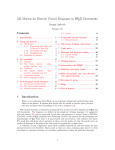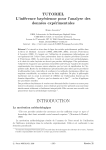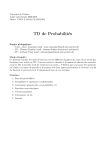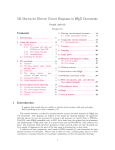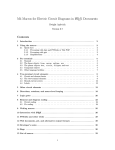Download Physics 445L Modern Physics Laboratory Atomic Spectroscopy
Transcript
Physics 445L Modern Physics Laboratory Atomic Spectroscopy 1 Introduction The description of atomic spectra and the Rutherford‐Geiger‐Marsden experiment were the most significant precursors of the so‐called Bohr “planetary” model of the atom. The Rutherford experiment was done in 1909 the description of atomic spectra, however, was developed over more than one hundred years. In 1814 Fraunhofer noticed dark lines in the spectrum of the sun. In 1859 Kirchhoff and Bunsen, while studying the bright lines emitted when elements are heated to high temperatures noted that “an element absorbs lines in the exact position as the lines it can emit.” Johann Balmer, in 1885 developed the formula that bears his name for the wavelengths of the visible spectral lines of hydrogen, λn = 364.6n2/(n2 ‐ 4). This formula was later generalized by Rydberg and Ritz. In this laboratory you will study the emission lines from various elements and several other sources. In addition to learning about the physics of spectra you will learn the important laboratory skills of calibrating an instrument and using a computer to collect experimental data. 2 Theory Wavelengths for the spectral lines of hydrogen are given by the Rydberg‐Ritz formula 1 1 1 = RH 2 − 2 m λmn n with n > m, where m and n are integers and RH is the Rydberg constant for hydrogen. € In 1913 Bohr proposed a model for the hydrogen atom with three postulates. 1. The electron moves in a circular orbit about the nucleus under the influence of the Coulomb potential, obeying the laws of classical mechanics . 2. In contrast to the infinite number of orbits allowed by classical physics, the Department of Physics 11/24/2009 University of Missouri‐Kansas City 1 of 10 electron can occupy only orbits for which its orbital angular momentum, Ln, is given by Ln = nh/2π where n = 1, 2, 3, ... . We frequently use the symbol = h /2π . Electrons are stable in such orbits, i.e., they have a well defined energy and do not emit radiation even though they are undergoing centripetal acceleration. Bohr termed these orbits stationary states. € 3. Radiation is emitted or absorbed when an electron transitions from one stationary state to another. The energy of the radiation, E = hν, is equal to the difference in the energies of the initial and final stationary states. Bohr’s model predicted that a transition from a state of higher energy (ni) to one of lower energy (nf) should result in the emission of radiation with energy hc mZ 2e 4 1 1 Ei − E f = = − λ (4 πε0 ) 2 2 2 n 2f n i2 where Z is the number of protons in the nucleus and e is the charge of the electron. Unfortunately, this did not agree with experimental spectral results. Therefore, Bohr soon modified € his postulates to require that the combined angular momentum of the electron and the nucleus, be quantized in units of h/2π which brought his model into conformance with experimental data. By replacing the mass of the electron m, with the reduced mass µ = mM/(M+m) where M is the mass of the nucleus, he obtained the following result for the emitted energy: hc µX Z 2e 4 1 1 € Ei − E f = = − λ (4 πε0 ) 2 2 2 n 2f n i2 here µX is the reduced mass of the atom X. Using the reduced mass implies that different isotopes of the same element will have different spectra. Bohr used his € model of the hydrogen atom to show that the Rydberg constant, RH, was related to other fundamental constants by the formula e2 RH = 8πε0 a0 hc and € e2 h= 8πε0 a0 R H c Here a0 is called the Bohr radius and is given by a0 = 4 πε0 2 /me e 2 € Department of Physics 11/24/2009 University of Missouri‐Kansas City € 2 of 10 3 The Experiments 3.1 Apparatus The apparatus for these experiments consists of several light sources, an optical fiber for directing the light into the spectrometer, which consists of a rotatable grating and two mirrors for directing the light, a solid state detector, and a computer for recording the data. Here is a picture of the spectrometer and the detector. Figure 1 Oriel spectrograph and detector Figure 2 Lamp 3.2 Setup First, read the Spectra‐Array software user manual and MS 125 1/8m spectrograph model 77400 documents. Familiarize yourself with the instrument and the LineSpec software. Second, it is important that all of the mechanical connections of the instrument be carefully and securely made so that the parts do not wobble out of alignment. If they seem loose, ask the lab assistant to fix them. 3.3 Calibration What is calibration and what does it do? Department of Physics 11/24/2009 University of Missouri‐Kansas City 3 of 10 It is not possible to measure the wavelength of light directly so we need to use an indirect measuring system. Indirect measuring systems require calibration. Consider the gasoline pump. In the early days they consisted of a glass cylinder with graduations showing the volume of gasoline in the cylinder. The amount of gasoline purchased could be read directly against these graduations. When pumps with rotary flow meters and mechanical quantity displays came into fashion these pumps measured the volume of gasoline indirectly by counting the rotations and converting the number of counts to a volume that was displayed. These pumps required periodic calibration to ensure that the amount displayed was accurate. The spectrograph used in this experiment requires similar calibration. (a) Direct measure pump (b) Rotary flow meter pump Figure 3 Although the exact procedure may vary from instrument to instrument, the calibration process generally involves using the instrument to test samples of one or more known values called calibrants. The calibrants used in these experiments are lines of very well known wavelengths from a mercury discharge tube. These lines fall onto pixels of the CCD detector. Calibration is essentially the assignment of pixels to known wavelength values. Mercury has a distinctive yellow doublet between approximately 575 and 580 nm and a strong single green line and single violet line as shown below. Yellow doublet at 578.97 nm and 576.96 nm Green line 546.074 nm Violet line 435.833 nm Department of Physics 11/24/2009 University of Missouri‐Kansas City 4 of 10 Figure 4 Location of lines of mercury used for calibration. The first step is to set the grating of the spectrometer to 546 nm. When the micrometer is set to 4 mm the grating is approximately centered at 400 nm; 5 mm corresponds to 500 nm and so forth. So 5.46 on the micrometer will move the grating so that it is approximately centered at 546 nm. To take a sample spectrum, select the Spectrum item from the Mode menu. Check the Sample box. Now select the third button from the left (Scan with Averaging) near the top of the of the LineSpec window. Enter 100 in the number of scans box and choose OK. The spectrum will appear in the Sample window of the Dump window. You may narrow the area around a peak by using the mouse to draw a selection box around it. • To determine the calibration coefficients using a spectral calibration lamp: Department of Physics 11/24/2009 University of Missouri‐Kansas City 5 of 10 1. Record the emission spectrum of a spectral calibration lamp for the appropriate detector (Master, Slave 1, Slave 2 or Slave 3. We only have a master.). An example of an emission spectrum corresponding to a spectral calibration lamp is shown in Figure 5. Figure 5 2. Select Wavelength Calibration from the Setup pull‐down menu to display the Wavelength calibration control window. Figure 6. Figure 6 3. Click the Calibrate using spectral lines button to display the Find calibration for a Master detector control window as shown in Figure 7. Department of Physics 11/24/2009 University of Missouri‐Kansas City 6 of 10 Figure 7 4. Find the position of a known spectral line using the mouse pointer. Note the position (pixel units) of the spectral line displayed in the status bar (see Figure 8 below): Figure 8 Department of Physics 11/24/2009 University of Missouri‐Kansas City 7 of 10 5. Click the Add button in the Find calibration control window to display the following window: Figure 9 Enter the pixel position of the spectral line and the known position in nanometer units. 6. Repeat steps 4 to 5 identifying at least three spectral lines that span the detection region of interest. It is best to try to use the lines farthest to the left and farthest to the right so that your calibration equation is interpolating rather than extrapolating. 7. Once the features of interest have been identified and assigned to known spectral lines, the program automatically calculates the wavelength calibration coefficients as shown in Figure 10: Department of Physics Figure 10 11/24/2009 University of Missouri‐Kansas City 8 of 10 The Edit button allows the user to modify any reference points within the table, while the Delete button allows points to be removed. 8. Click the Accept button to automatically update the wavelength calibration coefficients or Cancel to retain the original settings. 3.4 Procedures Take several measurements of each spectrum and use the mean as your result. • Observe the spectra from the incandescent and the fluorescent (overhead) light sources using the hand held spectroscope. Describe these spectra qualitatively. • Measure and record spectra from the fluorescent and incandescent light sources using the Oriel spectrograph. • Measure and record lines from the H, 2H (deuterium), He, Ne, Hg, and Xe lamps. • Measure and record lines from the white, blue and red LEDs. 4 Analysis When writing your report include all instrument parameters such as the grating constant, slit width, resolution, focal lengths, etc. Compare all of your results to currently accepted standard values and do error analyses. • Determine Rydberg’s constant for hydorgen and deuterium. • Compute Planck’s constant. • Find the ratio of the mass of deuterium to hydrogen. • Determine the ground state energy of hydrogen by using the Bohr model and the measured wavelengths of the lines in the Balmer series. Department of Physics 11/24/2009 University of Missouri‐Kansas City 9 of 10 APPENDIX 1 National Institute of Standards and Technology Physics Laboratory Basic Atomic Spectroscopy Data Mercury (Hg) Strong Lines of Mercury (Hg). The strongest lines are highlighted. Intensity 1000 400 60 100 1000 12 15 80 500 200 50 60 12 20 15 250 25 Air Wavelength (Å) 3983.931 4046.563 4339.223 4347.494 4358.328 5128.442 5204.768 5425.253 5460.735 5677.105 5769.598 5790.663 5871.279 5888.939 6146.435 6149.475 7081.90 Department of Physics 11/24/2009 University of Missouri‐Kansas City 10 of 10











